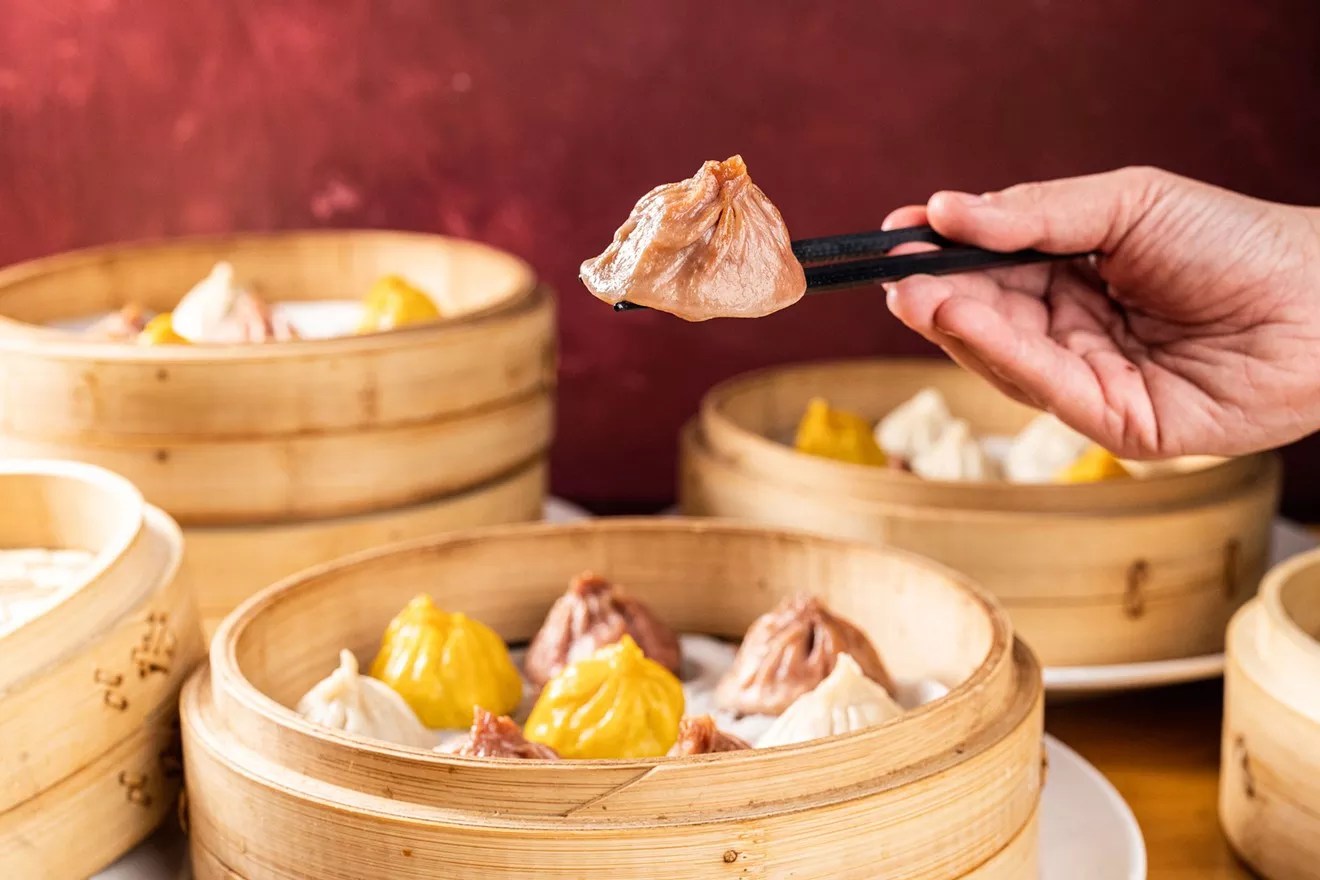
Kathy Tran

Audio By Carbonatix
Click here for our updated guide to dumplings in Dallas.
Yuan Teng arrives at his restaurant, Jeng Chi, every day at 4 a.m. to check on the dumpling dough. Yuan, from China, and his wife, Mei, from Taipei City, Taiwan, opened their restaurant in 1990 at a much smaller location with just four tables. The menu, in Mandarin, was on the wall, all family recipes. They expanded several times over the years, opening walls to adjacent suites.
In 2013, they moved to a much larger location in the same strip mall. Demand was so high that they were taking new orders while still sweeping up the sawdust from the construction and with no change in the cash register. Mei says originally all their customers were Chinese, but now people from everywhere walk through their doors.
To satiate those appetites, they make thousands of dumplings every day, each one hand-rolled, filled and pinched to an almost impossibly identical perfection.
Around 5 p.m. on a Wednesday, as early diners start to roll in, cooks clad in white chef coats and hats work quickly over a table behind a glass partition. One clips long ropes of dough – that very stuff Yuan checked on at 4 a.m. – into small, pillowy soft orbs. When a small mound is formed, it’s passed over to another cook, who quickly rolls a shiny metal rod over the ball, flattening it into a thin disk. One at a time, the disks are lightly tossed to Lilly, who has been making dumplings her entire life. Lilly scoops a mound of raw meat into the disk and, with a light and fast touch, spins and pinches shut the “small juicy” dumpling, the house specialty. This operation continues to hum along until 40 pounds of ground meat is sequestered in dough. And that’s just for one batch.
Will you step up to support Dallas Observer this year?
At the Dallas Observer, we’re small and scrappy — and we make the most of every dollar from our supporters. Right now, we’re $14,500 away from reaching our December 31 goal of $30,000. If you’ve ever learned something new, stayed informed, or felt more connected because of the Dallas Observer, now’s the time to give back.

Dumplings prepped at Jeng Chi.
Kathy Tran
Usually six dumpling makers work each day at Jeng Chi. “It’s a craft. It’s in the hand skills,” says Janelle Teng, who is the general manager and a co-owner. “To find people who have that experience already is getting harder and harder, and those who are naturally inclined, there’s just not that many.”
This raises a daunting question: Is making dumplings at this level a moribund trade?
“We’ll have applicants who come in who make dumplings at home as part of a tradition, but the rate at which we produce them here is much faster than what they would do home,” Janelle says.
Brandon is an exception. The 21-year-old cook was a rare find. “In 10 years, he is the only person who came on board who did not have experience who got it. It really clicked for him,” she says.
Fast, perfect dumplings aren’t an easy trade to teach. Some just have that sense and touch.
Every culture the world over seems to have some variation of foodstuff whose delivery system to our waiting maws is in the form of a wrapper with some sort of filling. Ravioli, samosas, empanadas, gyoza and potstickers all share that same basic form, along with a myriad of others spanning the globe from Eastern Europe to the Middle East, from East Asia to Western Asia and all parts in between.
Luckily for us, almost all have found their way to North Texas in one form or another: from fancy restaurants to food trucks, from strip mall locations to random pop-ups, dumpling are waiting to be discovered and eaten in a tasty and satisfying celebration of the ubiquitous and versatile food, in all shapes and sizes.
North Texas has especially embraced the dumplings from Korea, Japan, Nepal and the granddaddy of them all, China. We do this in an effort to produce a dumpling primer that isn’t as lengthy as Tolstoy’s War and Peace and shouldn’t be taken as a commentary about the worth of other cultures’ dumplings; they just deserve their own survey.
One of the most common versions of the dumpling, and probably the one that most people think of when they think dumpling, are of the Chinese variety, often referred to as the simple potsticker. In reality, there are several subtypes of Chinese dumplings that can be prepared in several ways, including steamed, pan-fried or boiled, such as har gao (shrimp), wonton (boiled), sheng jian bao (pan-fried), xiao long bao (steamed) and jiaozi, which can be prepared all three ways. The fillings, furthermore, can be shrimp, pork, cabbage, soup or any combination thereof.
Making both the wrapper and filling can be extremely labor-intensive and time-consuming. Jeng Chi has specialized in Taiwanese and Chinese fare for more than three decades and serves perhaps the best pork soup dumplings (xiao long bao) in the area.
Jeng Chi, 400 N. Greenville Ave., No. 11, in Richardson, offers five varieties of xiao long bao: small, beef, pork and crab, chicken curry and fiery, along with several other types of dumplings, many of which can be purchased frozen to be cooked at home. Every day they welcome new diners to experience juicy soup dumplings for the first time, teaching them the secret to enjoying them without burning their tongues.
At the back of the open dining room is the dumpling prep area. Diners can kill time while waiting for a table by watching the dumpling artisans rolling, cutting, shaping and filling.
Jeng Chi and its “small juicy” are just one of the dozens of options in the DFW area for your dumpling fix.
We’ve recently updated this article, and you can find the new guide here.